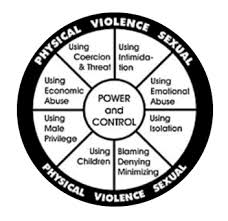Domestic Violence is:Any abusive or coercive behavior used control an intimate partner. This includes multiple actions; a pattern of manipulative and violent tactics where the victim is forced to change her behavior in response to the abuse. Cycle of Violence:Phase 1- Tension
Increased tension, 'walking on eggshells", anger, blaming, verbal threats, arguing, breakdown in communication Phase 2- Incident Battering, hitting, pushing, shoving, slapping, kicking, chocking, using objects as weapons, lethal weapons, sexual abuse Phase 3- Honeymoon Abuser will deny violence, make excuses for behavior(drunk, stressed, upset, etc.), will say sorry and promise it will never happen again. Over time the honeymoon phase disappears and you go from incident to tension and back again over and over. Referrals:211 Area Information
211 APS/CPS 24 Hour Hotline 1-800-252-5400 Al-Anon 325-657-6640 Alcoholics Anonymous 325-657-6640 Alcohol and Drug Abuse Council 325-224-3481 ADDAC Hot Line 1-800-880-9641 American Red Cross 325-658-4409 Attorney General's Office 325-653-7326 Boys and Girls Club 325-988-8343 Catholic Outreach 325-617-7292 Christians in Action .325-655-5127 Crime Victims Compensation .1-800-983-9933 Electric Service providers www.powertochoose.com Family Shelter 325-655-5774 Food Stamps/TANF 325-655-0576 High Sky Children’s Services 325-947-7233 Indigent Health Care 325-659-6504 Tom Green County Jail 325-659-6597 La Esperanza Clinic 325-658-5339 MHMR Crisis Hotline 325-653-5933 MHMR Mental Health Services 325-658-7750 Open Arms Rape Crisis and LGBT+. 325-655-2000 Open Arms Hotline 325-658-8888 Rust St. Ministries 325-486-1004 Salvation Army 325-655-6981 VINE www.vinelink.com 1-877-894-8463 WIC 325-657-4396 Workforce Solutions 325-653-2321 All clients are given a list of crime victims' rights.
A copy of the Texas Crime Victims rights policy is available at the CIU offices. |
Facts:Family violence is a crime.
Most victims are women (85%). Most abusers are men. Family violence occurs in all races, ages, and religions. It happens at all income levels. Nobody “deserves” to be beaten. 3-4 million women are beaten in their homes each year by husbands or partners. Attacks by husbands on wives result in more emergency room visits than rape, auto accidents, and muggings combined. Family Violence occurs in current or former dating, married or cohabiting relationships of heterosexuals or LGBT+ individuals. We use the term “battered woman,” since the overwhelming majority of family violence is perpetrated by men against women. Effects of Battering:Women Isolation low self esteem Increased alcohol abuse Emotional problems Permanent physical damage Repetition of abusive behavior Children Emotional Problems Illness Increased fears, anger Increased risk of abuse, injuries, and death Repetition of abusive behavior Abusers- increased belief that power and control are achieved by violence Increased violent behavior Increased contact with law enforcement Increased emotional problems, decreased self-esteem Possible Outcomes:Stay in the abusive relationship and become passive.
Stay in the abusive relationship and become combative. Leave the abusive relationship. Power and Control Tactics:Physical and Sexual abuse
Emotional Abuse Intimidation Coercion and threats Economic abuse Male Privilege Using the children Isolation Minimizing, denying, blaming Barriers to Leaving:Relentless behavior of the abuser:
When faced with losing control of their partner through separation or intervention, abusers often turn their attention toward getting their victim back using kindness or cruelty, or both in a continuous, repetitive manner. Fear of what the abuser might do: to the victim, children, or other family members. Fear for the children: The abuser often threatens to take the children, telling the victim that the courts would side with him. Financial dependence: Inability to afford practical things such as food and rent on their own. Conflicts with religious beliefs Isolation/lack of support: A victim who has been isolated by their abuser may believe that no one will believe them. They may be surrounded by the abuser's family and not their own so they have no support around them. Shame/making excuses for the abuser: Victim often believe they themselves, are responsible for the abuse. They are told by the abuser that the abuse is their fault so often they begin to believe it. |
Indicators that an abuser has a strong potential to kill:
Owns or has access to a weapon Abuser has addiction problems
Increased violence over the past year Abuser is unemployed
Having a child that is not his Depression
Threatens to kill you Separation, or threatened separation, from the abuser
Avoids being arrested (running from law enforcement)
Threatens Suicide Feel they own you
Chokes you Stalks you
Is controlling and jealous Beat you while you were pregnant
YOU BELIEVE HE IS CAPABLE OF KILLING YOU
IF YOU SAID YES TO MORE THAN 8 OF THESE THE ABUSER SHOULD BE CONSIDERED EXTREMELY DANGEROUS
Increased violence over the past year Abuser is unemployed
Having a child that is not his Depression
Threatens to kill you Separation, or threatened separation, from the abuser
Avoids being arrested (running from law enforcement)
Threatens Suicide Feel they own you
Chokes you Stalks you
Is controlling and jealous Beat you while you were pregnant
YOU BELIEVE HE IS CAPABLE OF KILLING YOU
IF YOU SAID YES TO MORE THAN 8 OF THESE THE ABUSER SHOULD BE CONSIDERED EXTREMELY DANGEROUS

